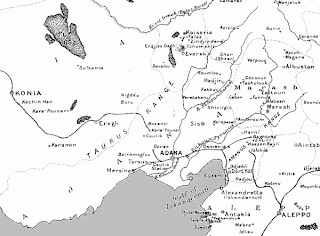On 1916 semi-postal stamp of Turkey
Quick HistoryCilicia is presently part of southern Turkey, adjacent to the Mediterranean Sea. The population was 380,000, and the Capital was Adana.
Cilicia in present day southern Turkey
Cilicia was occupied by the British and French in 1918 after the upheaval of WWI, and the French took control in 1919. Stamps were issued under the French Occupation from 1919-1921. Stamps of Turkey were either handstamped or overprinted "Cilicie" initially. Then Newspaper stamps were used, stamps of the French Offices in Turkey were surcharged, and finally stamps of France were surcharged.Cilicia Map
At the beginning of the occupation, Cilicia was part of the French Mandated Territory of Syria. But in 1923, Cilicia reverted to Turkey.1919 Scott 5 1 3/4pi slate & red brown "Fountains of Suleiman"
Handstamped, On stamps of Turkey, 1913
Big Blue PictureThe '69 editors removed the territory from the edition, and it did not return in the '97. Cilicia is found in the '47 and '41 editions on 1/2 page after the Costa Rica section. There are 16 stamp spaces. The 2011 Scott Classic specialized catalogue lists 145 major stamp descriptions. Coverage by Big Blue was 11%.
Rather interesting philatelic history, with all the 1919-21 issues of Cilicia from handstamped/overprinted Turkey or French stamps. Most of Big Blue's selection are priced in the rather expensive $2+-$20+ bracket. This is not an anomaly, as many of Cilicia's stamps are in this price range.
The '47 and '41 editions had 16 stamp spaces for Cilicia
Most Big Blues have few Cilicia stamps
Nevertheless, I did find some 19 stamps ranging from <$1-$2+ that could be added.Additionals..
6,12,22,31,34,43,56,57,58,82,83,83C,87,93,98,100,101,102,104, (<$1-$2+)
1919 Scott 83 2pi orange brown & indigo
"Istanbul Across the Golden Horn"
Overprinted, On stamps of Turkey, 1913-19
Big Blue Checklist "47 & '41 editions1919 overprinted "Cilicie"
"Turkey stamp of 1901 surcharged Crescent and Star of 1915 (Scott 300)"
53($5+) :1 Pi blue
"Same on Turkey Commemorative stamps of 1916 (Scott 349)"
59($10+): 5 Pi yellow brown and black
"Stamps of Turkey 1916-19 overprinted "T.E.O. Cilicie"
75($2+): 1 Pi blue
77($10+): 20 Pa ultramarine
"Same on stamps of 1916-18"
79($2+):5 Pa orange
"Black surcharge"
81*($20+): 20 Pa deep rose
*Note: BB specifies 81 with black surcharge( $20+); 82 20 Pa deep rose with blue surcharge is <$1.
"On Newspaper stamp of 1919"
88 (<$1):5 Pa on 2 Pa olive green
On semi-postal stamps of 1915-17
91($2+): 10 Pa carmine
92($2+): 10 Pa on 20 Pa violet brown
(1920 blue surcharge)
99($2+): Illust: 3 1/2pi on 5pa red
1920 Stamps of France 1900-17, Surcharged
117(<$1), 119 (<$1), 121(<$1), 122($1+), 123 ($$2+), 124 ($3+),
Note: The BB illustration is for the first setting: 1.75-2mm space between "Cilicie" and the figure of value. There are minor number second setting ( 1-1.5mm space) values, however, that could be put into the spaces.
Note: I made a mistake with the initial checklist, putting in Scott 101-106. These, however, have a different overprint.
1919 Scott 93 10pa red violet "A Soldiers Farewell"
Overprinted, on semi-postal stamps of Turkey, 1915-17
Kinds of BlueThe '47 and '41 editions are identical in content. Cilicia is not in the '69 and '97 editions.
1920 Scott 119 10pa on 5c green/grayish (GC)
Surcharged, On stamps of France, 1900-17
Big Blue Bottom LineQuite fascinating the obscure (to me) occupied territories with their resulting philatelic history. Cilicia is even more obscure as it is not in the '69 or '97 editions. I will make room, using the '47 edition inclusions as a template, in my '97.
Note: Maps appear to be in the Public domain.
If you enjoyed this post, or have some information to share, or have some constructive criticism, please share your thoughts and reactions in the "comment" section. Thanks!
Note: You will need to consult a Scott catalogue for specific pricing. I only give a very "ball park" price, and never the actual catalogue value.
<$1= less than a Dollar
$1+= more than a Dollar
$2+= more than two Dollars
$5+= more than five Dollars
$10+= more than ten Dollars
$20+..and so on.













